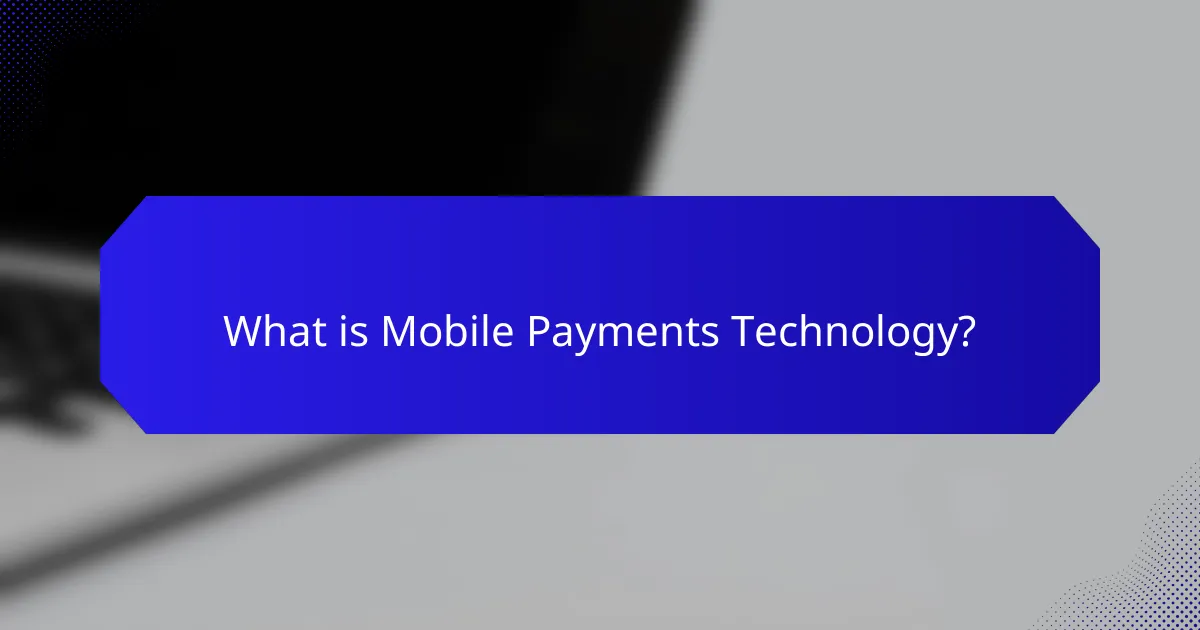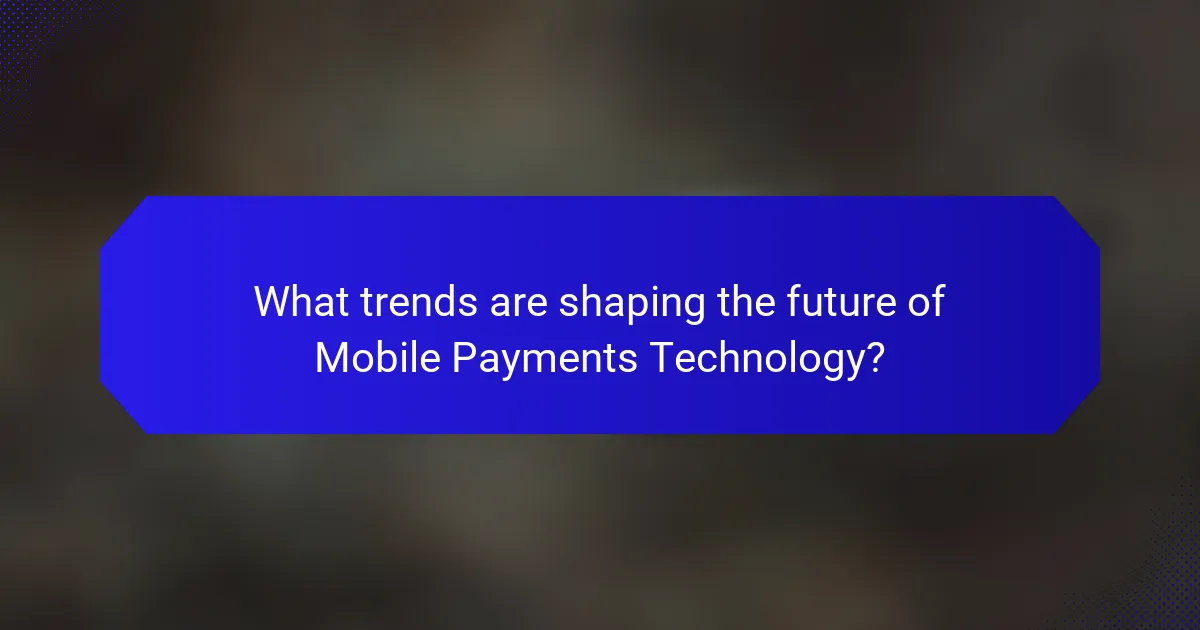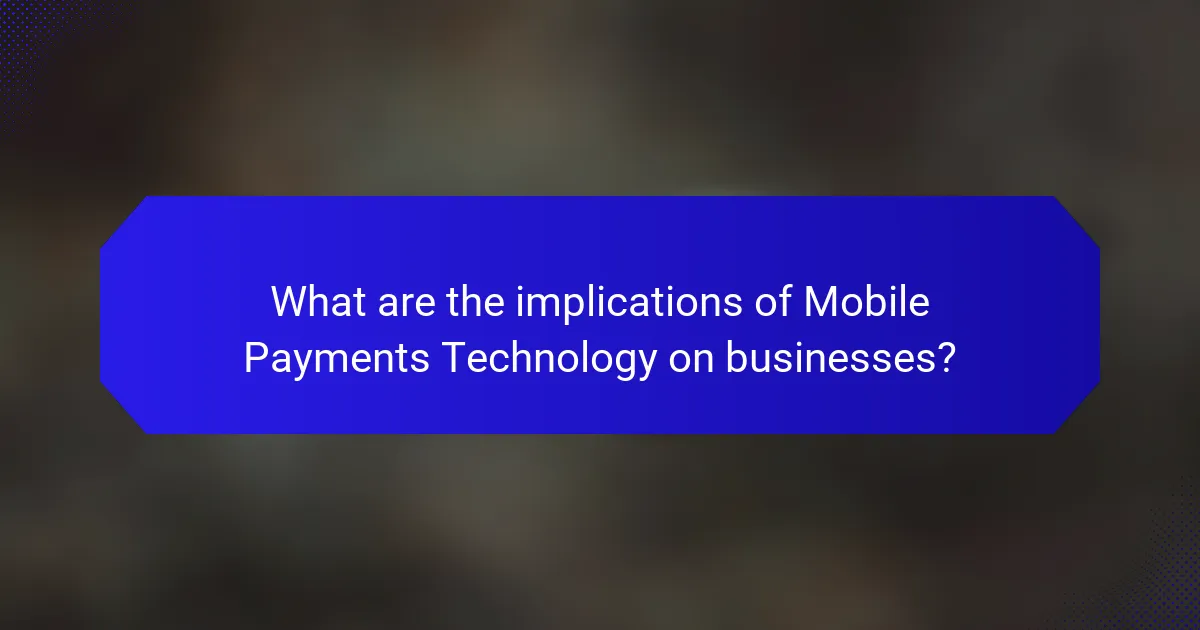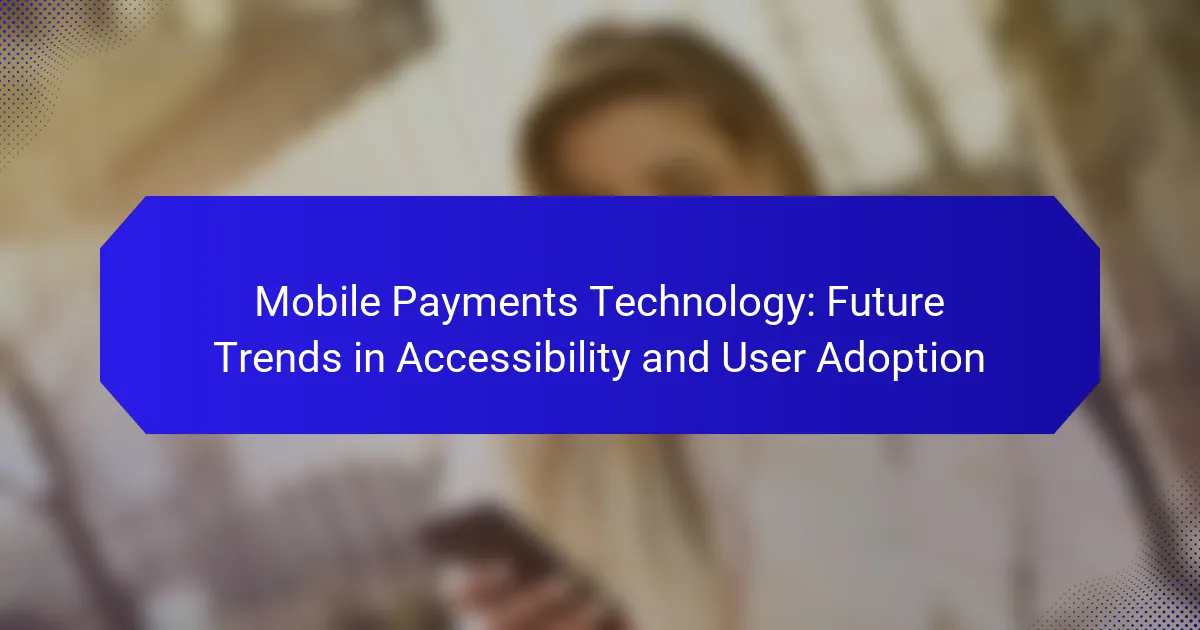Mobile payments technology enables financial transactions through mobile devices such as smartphones and tablets, utilizing methods like near-field communication (NFC), QR codes, and mobile wallets. The global mobile payment market was valued at approximately $1.48 trillion in 2021 and is projected to reach $12.06 trillion by 2025, reflecting a significant shift in consumer preferences towards digital payment methods. Key trends influencing this technology include the rise of contactless payments, the integration of biometric authentication for enhanced security, and the growing adoption of digital wallets. Additionally, advancements in blockchain technology and the expansion of e-commerce are driving user adoption and accessibility, while businesses benefit from increased transaction efficiency and improved customer experiences.

What is Mobile Payments Technology?
Mobile payments technology refers to the use of mobile devices to make financial transactions. This technology allows users to pay for goods and services through their smartphones or tablets. It utilizes various methods, including near-field communication (NFC), QR codes, and mobile wallets. According to Statista, the global mobile payment market was valued at approximately $1.48 trillion in 2021. This figure is expected to grow significantly, indicating increasing user adoption and accessibility. Mobile payments enhance convenience by allowing instant transactions without the need for cash or physical cards.
How does Mobile Payments Technology function?
Mobile payments technology functions by enabling transactions through mobile devices. This process typically involves the use of applications and digital wallets. Users link their bank accounts or credit cards to these apps. When making a purchase, the user selects the payment method within the app. The app then generates a secure token or QR code. This token is transmitted to the merchant’s payment terminal. The terminal processes the payment via a payment gateway. According to Statista, mobile payments are expected to reach $12 trillion globally by 2025, illustrating the growing adoption of this technology.
What are the key components of Mobile Payments Technology?
The key components of mobile payments technology include mobile wallets, payment gateways, and Near Field Communication (NFC). Mobile wallets allow users to store payment information securely on their devices. Payment gateways facilitate the transaction process between the buyer and the seller. NFC technology enables contactless payments by allowing devices to communicate wirelessly over short distances. Additionally, security features such as encryption and tokenization are crucial for protecting user data during transactions. These components work together to provide a seamless payment experience for users.
How do these components interact in the payment process?
In the payment process, components such as the payment gateway, processor, and bank interact to facilitate transactions. The payment gateway securely transmits transaction data from the customer to the payment processor. The payment processor then verifies the transaction with the customer’s bank. Upon verification, the funds are transferred from the customer’s account to the merchant’s account. Each component plays a critical role in ensuring secure and efficient payment processing. The interaction occurs in real-time, allowing for immediate transaction confirmation. According to a report by Statista, mobile payment transactions are expected to exceed $1 trillion by 2024, highlighting the importance of these components in the evolving payment landscape.
What are the main types of Mobile Payments Technology?
The main types of mobile payments technology include Near Field Communication (NFC), Mobile Wallets, and QR Code payments. NFC allows for contactless transactions between devices. Mobile Wallets store payment information securely on a smartphone. QR Code payments enable users to scan codes for transactions. These technologies facilitate quick and convenient payment methods. According to a report by Statista, mobile payment transaction value is expected to reach $12 trillion by 2024. This growth highlights the increasing adoption of these technologies in everyday transactions.
What is the difference between NFC and QR code payments?
NFC payments use near-field communication technology for contactless transactions. QR code payments rely on scanning a two-dimensional barcode with a smartphone camera. NFC transactions are typically faster, as they require only a tap to complete. In contrast, QR code payments involve a scanning process that may take slightly longer. NFC requires compatible devices to be in close proximity, usually within a few centimeters. QR codes can be scanned from a distance, allowing for more flexibility in usage. Security measures differ; NFC transactions often utilize encryption and tokenization. QR codes can be vulnerable to phishing if not properly secured.
How do mobile wallets differ from traditional banking apps?
Mobile wallets differ from traditional banking apps primarily in their functionality and user experience. Mobile wallets focus on facilitating quick and easy transactions, often using QR codes or NFC technology. They allow users to store payment information securely and make purchases directly from their mobile devices. Traditional banking apps, on the other hand, provide a broader range of banking services, including account management, transfers, and bill payments.
Mobile wallets typically emphasize convenience and speed for retail transactions. They often integrate loyalty programs and promotional offers. Traditional banking apps prioritize comprehensive financial management and security features. They usually require more detailed user verification for transactions.
Data from a 2021 report by Statista shows that mobile wallet usage surged, with over 2 billion users globally. This indicates a growing preference for mobile wallets over traditional banking methods, especially among younger consumers.

What trends are shaping the future of Mobile Payments Technology?
Mobile payments technology is being shaped by several key trends. The rise of contactless payments is significant, with a 40% increase in usage reported in 2021. Integration of biometric authentication is also gaining traction, enhancing security and user convenience. The adoption of digital wallets continues to expand, driven by consumer preference for seamless transactions. Additionally, advancements in blockchain technology are facilitating faster and more secure payment processes. The growth of e-commerce has further accelerated mobile payment adoption, with 70% of online shoppers using mobile payment options in 2022. Lastly, the increasing focus on financial inclusion is prompting innovative solutions for underserved populations, expanding access to mobile payment systems.
How is user adoption of Mobile Payments Technology evolving?
User adoption of mobile payments technology is rapidly increasing. In 2022, over 1 billion people worldwide used mobile payment services. This growth is driven by the convenience and security offered by digital wallets. Consumers prefer mobile payments for their speed and ease of use. Additionally, the COVID-19 pandemic accelerated the shift towards contactless transactions. Research shows that 60% of consumers now prefer mobile payments over cash. Major retailers are also adopting mobile payment options to meet consumer demand. As smartphone [censured] rises, user adoption is expected to continue growing.
What demographic factors influence user adoption rates?
Demographic factors that influence user adoption rates include age, income, education, and geographic location. Younger individuals tend to adopt new technologies more quickly than older generations. Higher income levels correlate with increased adoption due to greater access to resources. Education also plays a role; those with higher education levels often show greater comfort with technology. Geographic location affects access to mobile payment infrastructure, impacting adoption rates. For example, urban areas typically have higher adoption rates compared to rural regions. These factors collectively shape how different demographics engage with mobile payment technology.
How do cultural attitudes affect the acceptance of mobile payments?
Cultural attitudes significantly influence the acceptance of mobile payments. In cultures that prioritize innovation and technology, mobile payment adoption tends to be higher. For example, countries like Sweden and China have embraced mobile payments due to positive cultural perceptions of technology. Conversely, cultures with a strong preference for cash transactions may resist mobile payment adoption. In many regions, trust in digital systems plays a crucial role. Research indicates that cultural factors, such as collectivism versus individualism, impact users’ willingness to adopt new payment methods. Overall, cultural attitudes shape perceptions of security, convenience, and the overall value of mobile payments.
What role does accessibility play in Mobile Payments Technology?
Accessibility is crucial in mobile payments technology as it ensures that all users, including those with disabilities, can effectively utilize payment systems. This inclusivity enhances user experience and broadens market reach. Features like voice recognition, screen readers, and simplified interfaces cater to diverse user needs. According to the World Health Organization, over 1 billion people live with some form of disability, highlighting the importance of accessible mobile payment solutions. Companies that prioritize accessibility can increase customer satisfaction and loyalty, leading to higher adoption rates. Thus, accessibility directly impacts the success and usability of mobile payment technologies.
How can Mobile Payments Technology be made more accessible to diverse users?
Mobile payments technology can be made more accessible to diverse users by implementing user-friendly interfaces and multilingual support. Simplifying the design allows users of varying tech proficiency to navigate easily. Incorporating voice recognition can aid users with disabilities or those who prefer auditory commands. Offering educational resources enhances understanding for users unfamiliar with mobile payments. Ensuring compatibility with various devices increases reach to users with different technology access. Additionally, integrating biometric authentication can provide secure, convenient access for all users. Research shows that 70% of users prefer systems that accommodate their specific needs, highlighting the importance of tailored solutions.
What are the challenges faced in ensuring accessibility?
The challenges faced in ensuring accessibility include technological barriers, lack of awareness, and insufficient funding. Technological barriers arise when mobile payment systems are not designed with accessibility features. This limits usability for individuals with disabilities. Lack of awareness among developers about accessibility needs can lead to neglect in design. Insufficient funding for accessibility initiatives can hinder the implementation of necessary features. According to the World Health Organization, over 1 billion people live with disabilities, highlighting the need for inclusive design. Therefore, addressing these challenges is crucial for enhancing accessibility in mobile payment technology.

What are the implications of Mobile Payments Technology on businesses?
Mobile payments technology significantly impacts businesses by enhancing transaction efficiency and customer experience. It allows for quicker checkouts, reducing wait times for customers. According to a report by Statista, mobile payment transaction value is projected to reach $12.06 trillion by 2025. This growth indicates a shift in consumer preferences towards digital payment methods. Businesses adopting mobile payment solutions can increase sales through improved customer satisfaction. Additionally, mobile payments can reduce cash handling costs and increase security against fraud. The integration of mobile wallets also enables businesses to gather valuable consumer data for targeted marketing strategies. Overall, mobile payments technology drives operational efficiency and customer engagement in the modern business landscape.
How can businesses leverage Mobile Payments Technology for growth?
Businesses can leverage Mobile Payments Technology for growth by enhancing customer convenience and streamlining transactions. This technology allows for quicker payment processing, reducing wait times at checkout. According to a study by Statista, mobile payment users are expected to reach 1.31 billion by 2023.
Integrating mobile payments can attract tech-savvy customers. It also enables businesses to offer promotions and loyalty programs directly through payment platforms. This can increase customer retention and encourage repeat purchases.
Additionally, mobile payments provide valuable data analytics. Businesses can track consumer spending patterns and preferences. This information can inform marketing strategies and inventory management.
By adopting Mobile Payments Technology, businesses can improve operational efficiency and drive revenue growth.
What are the potential cost savings associated with adopting mobile payments?
Adopting mobile payments can lead to significant cost savings for businesses. These savings stem from reduced transaction fees compared to traditional payment methods. Mobile payments often incur lower processing costs, which can decrease overall expenses. Additionally, mobile payments streamline operations, reducing labor costs associated with cash handling and manual processing.
A study by the Boston Consulting Group found that businesses can save up to 2% per transaction by switching to mobile payment systems. Furthermore, mobile payments enhance customer experience, leading to increased sales and customer retention. These factors collectively contribute to a more efficient and cost-effective payment process for businesses.
How can mobile payments enhance customer experience?
Mobile payments enhance customer experience by providing convenience and speed during transactions. Customers can complete purchases quickly using their smartphones. This reduces wait times at checkout, improving overall satisfaction. Mobile payments also offer secure transactions, increasing customer trust. According to a 2021 study by Statista, 45% of consumers prefer mobile payments for their ease of use. Additionally, mobile payment systems often include loyalty programs, rewarding customers for their purchases. This personalization fosters customer loyalty and enhances the shopping experience. Overall, mobile payments streamline the purchasing process and elevate customer engagement.
What best practices should businesses follow when implementing Mobile Payments Technology?
Businesses should prioritize security, user experience, and compliance when implementing mobile payments technology. They must ensure data encryption to protect sensitive customer information. Regular updates and patches are essential to address vulnerabilities. User-friendly interfaces enhance customer satisfaction and adoption rates. Offering multiple payment options can cater to diverse customer preferences. Training staff on mobile payment systems ensures effective implementation. Businesses should also comply with local regulations and standards to avoid legal issues. According to a report by Statista, the mobile payment market is projected to reach $12.06 trillion by 2025, highlighting the importance of adopting best practices in this growing sector.
What security measures are essential for mobile payment systems?
Essential security measures for mobile payment systems include encryption, tokenization, and biometric authentication. Encryption protects sensitive data during transmission. It ensures that information is unreadable to unauthorized parties. Tokenization replaces sensitive data with unique identifiers. This minimizes the risk of data breaches. Biometric authentication uses fingerprints or [censured] recognition for user verification. It adds an extra layer of security. Regular software updates are also crucial. They address vulnerabilities and enhance system security. Compliance with standards like PCI DSS ensures secure payment processing. These measures collectively safeguard user information and build trust in mobile payment systems.
How can businesses effectively educate customers about mobile payment options?
Businesses can effectively educate customers about mobile payment options through clear communication and hands-on demonstrations. They should provide detailed information on the benefits and security of mobile payments. This can include sharing statistics, such as that 75% of consumers prefer mobile payments for convenience (Source: Statista, 2021).
Offering in-store workshops can help customers understand the technology. Online tutorials and FAQs can also be valuable resources. Engaging customers through social media can facilitate discussions and answer questions.
Additionally, businesses should highlight user-friendly features of mobile payment apps. Promoting success stories can build trust in mobile payment systems. Regular updates on new features will keep customers informed and interested.
Mobile payments technology refers to the use of mobile devices for financial transactions, enabling users to pay for goods and services through smartphones or tablets. The article explores how this technology functions, its key components such as mobile wallets and payment gateways, and the various types including NFC and QR code payments. It also examines trends shaping the future of mobile payments, user adoption rates influenced by demographic and cultural factors, and the implications for businesses, including cost savings and enhanced customer experience. Additionally, the article highlights the importance of accessibility in mobile payments and best practices for businesses to effectively implement and educate customers about these technologies.
